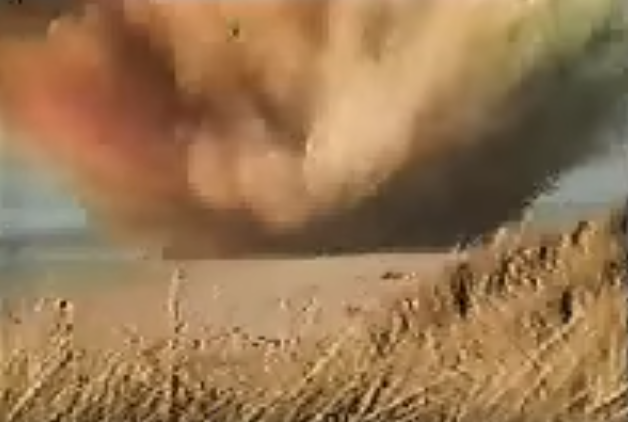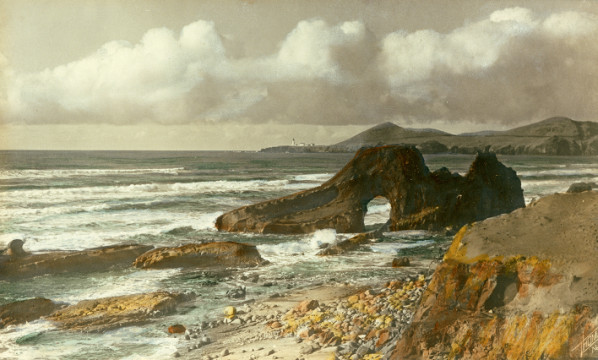In the early morning hours of October 12, 1931, a large creature was spotted in the Columbia Slough, a narrow channel of water about nineteen miles long that runs parallel to the Columbia River north of Portland. The orca (or killer whale) attracted a spectacle and prompted two weeks of debates over whether to kill the animal or save it. While the business of displaying captive orcas would not emerge until the mid-1960s, the whale trapped in the Columbia Slough provided a glimpse of what the entertainment value might be.
As word spread, some people arrived at the slough with movie cameras and others brought rifles to take potshots. Governor Julius Meier ordered that the orca be protected, but two men were arrested while attempting to shoot the whale from boats just a day later. Multnomah County District Court Judge John A. Mears dismissed the charges against the men after District Attorney Lotus L. Langley admitted he did not know whether the animal was a whale or a fish. The whale was given names—Ethelbert, favored by Portlanders; Oswald, preferred by Vancouverites; Moby Mary or Egbert, imagined by newspapers outside the metro area.
Portland had whale fever. On the first weekend, ten thousand people rushed to catch a glimpse of the visitor. The crowds caused gridlock on the highway bridge between Portland and Vancouver, requiring a dozen traffic officers and deputy sheriffs to manage the jams. The Oregonian and Daily Journal published front-page features, and vendors set up popcorn and hot dog stands. For ten cents, onlookers could board a boat to get a closer look or an airplane to see the animal from above.
Local fishers proposed capturing the whale. They hoped to corral it with boats, herd it into a gill net—220 feet long and 18 feet deep—and roll it up the bank to the Jantzen Beach swimming pool. The Oregon Humane Society argued that any capture would be inhumane and that the Jantzen pool was “not deep enough or big enough to be comfortable for the whale.” With advice from Bryon B. Allison, a former chief engineer for the Pacific-American Whaling Company, the Humane Society’s board offered to put the whale out of its misery with dynamite. Naturalist William Finley opposed both ideas. “Putting him in an enclosure of salt water [sic] is all tommyrot,” he told the Oregonian. “He can’t be fed like a chicken or a cat. And he’ll find his way out when he gets ready.”
A third proposal emerged. The Oregonian’s James McCool envisioned a rescue operation involving “a line of tugboats and motorboats” with “whistles blowing and bells ringing” to urge the whale into the Columbia River, where it could make its way to the Pacific. But as his plan was unfolding on kitchen tables, Portlanders Edward O. Lessard and his son Joe killed the whale with harpoons. The men were arrested.
Local fishers pulled the orca’s body from the slough, tied it to a boat, and charged ten cents for a boat ride to see it. Eventually, the police seized the whale as state’s evidence, and it was placed in a metal tank, complete with a dorsal fin notch, and preserved in some 400 gallons of formaldehyde. After the whale was exhibited at the Sigert, Hart and Yett Sand and Gravel Company and at a parking lot at Southwest First and Jefferson in Portland, it was hung by its tail at the county courthouse.
The harpooners were convicted on November 6, 1931, and were fined $200 each, with Judge Mears again presiding. They won an appeal to the Circuit Court in December, when Judge Hall S. Lusk ruled that the whale was not a fish and thus not covered by fisheries regulations. The whale was returned to the Lessards, who took the body on tour. The state appointed special prosecutor George Shepherd to appeal Lusk’s decision to the Oregon Supreme Court. Because no laws governed the treatment of inland whales, Shepherd argued that common law held that freshwater whales were “Royal Fishes” and thus the property of the governor. The court agreed, and on February 6, 1934, the harpooners were ordered to transfer the orca to the state. The Lessards appealed to the Circuit Court in July 1935 and were ordered to turn the whale over or pay $1,000.
For four years, the Lessards refused to give up the whale. The Oregon Board of Control finally offered to drop the case if Edward Lessard agreed to pay court costs of around $103. In 1939, the Lessards moved the whale to an orchard property they owned near St. Helens, Washington. By 1949, the decomposing animal was setting off a stink, and the Lessard family buried it in a forested area in Clark County. Thirty years later, timber inspectors found the remains and re-buried the orca on a mountain north of Washougal.
Oregon Sound News, c. 1931.
Courtesy the Oregon Historical Society, MI# 07834. Transferred from an original 35mm nitrate print by ColorLab (Rockville, MD).
-
![]()
"A Study in Unnatural History," Oregonian cartoon, Oct. 14, 1931.
Courtesy Portland Oregonian
-
![]()
Edward Lessard, 1931.
Oregon Historical Society Research Library, Journal, 371N1506
-
![]()
Joe Lessard, 1931.
Oregon Historical Society Research Library, Journal, 371N1507
-
![]()
Columbia Slough, c. 1910.
Oregon Historical Society Research Library, Kiser Studios, bb000226
-
![]()
"The Whale in the Slough," Oregonian, Oct. 21, 1931.
Courtesy Portland Oregonian
-
![]()
"Humane Disposal Sought for Whale," Oregonian, October 21, 1931.
Courtesy Portland Oregonian
-
![]()
"Playful Whale Done to Death," Oregonian, Oct. 25, 1931.
Courtesy Portland Oregonian
-
![]()
"Whale's Remains Put On Exhibition," Oregonian, Oct. 26, 1931.
Courtesy Portland Oregonian
-
![]()
"Whale's Killers Face Legal Maze," Oregonian, Oct. 27, 1931.
Courtesy Portland Oregonian
-
![]()
"A Whale of A Wonder," Oregonian, Nov. 7, 1931.
Courtesy Portland Oregonian
Related Entries
-
![Florence Whale Explosion]()
Florence Whale Explosion
On November 9, 1970, a forty-five-foot, eight-ton sperm whale washed as…
-
![Keiko]()
Keiko
Keiko, a male orca (orcinus orca) originally captured in 1979 from a po…
-
![William L. Finley (1876–1953)]()
William L. Finley (1876–1953)
Oregon's birds have had few better friends than William Lovell Finley. …
Map This on the Oregon History WayFinder
The Oregon History Wayfinder is an interactive map that identifies significant places, people, and events in Oregon history.
Further Reading
"The Whale in the Slough." Portland Oregonian, October 21, 1931.
"Shooting at Whale Stirs Up Citizenry." Portland Oregonian, October 14, 1931.
"Whale Plays Game of tag with Boats." Portland Oregonian, October 19, 1931.
"Humane Disposal Sought for Whale." Portland Oregonian, October 21, 1931.
"Playful Whale Done to Death: Crowds Watch in Vain for Slain Friend." Portland Oregonian, October 25, 1931.
"Whale's Killers Face Legal Maze." Portland Oregonian, October 27, 1931.
"Dead Whale viewed Inside Pickling Vat." Portland Oregonian, October 31, 1931.
"A Whale of a Wonder." Portland Oregonian, November 7, 1931.
"Old whale's final rites performed by loggers." Portland Oregonian., August 29, 1979.
"Humphrey's story stirs memories of wayward Portland whale." Portland Oregonian, November 13, 1985.













